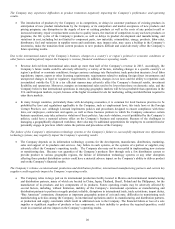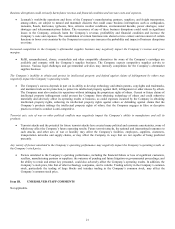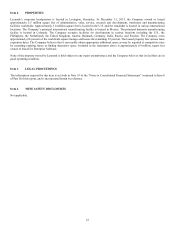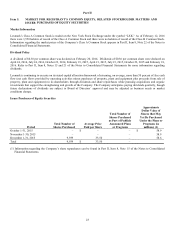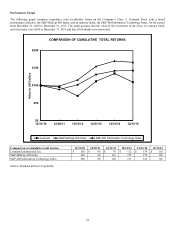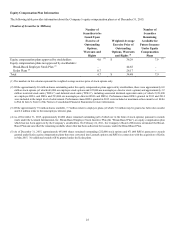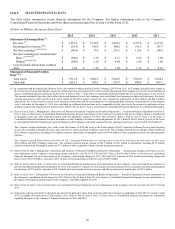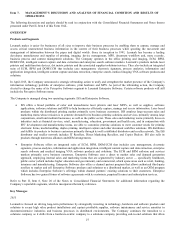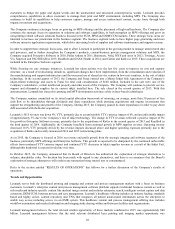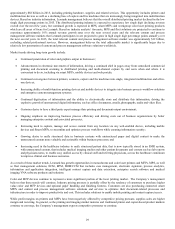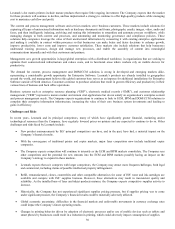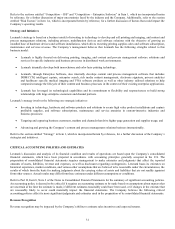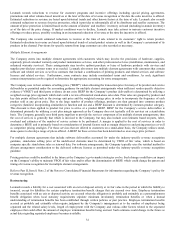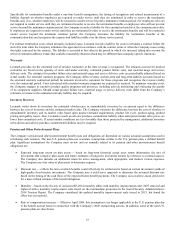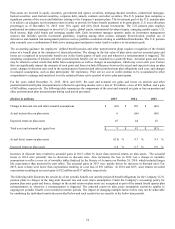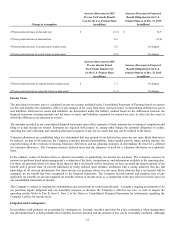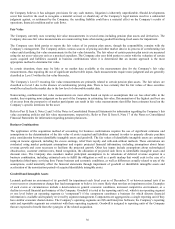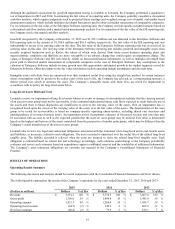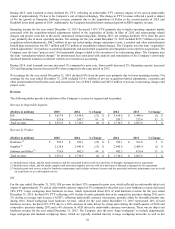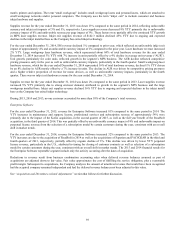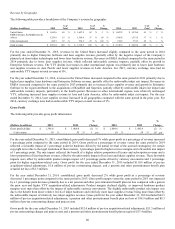Lexmark 2015 Annual Report Download - page 34
Download and view the complete annual report
Please find page 34 of the 2015 Lexmark annual report below. You can navigate through the pages in the report by either clicking on the pages listed below, or by using the keyword search tool below to find specific information within the annual report.30
Lexmark’s dot matrix printers include mature products that require little ongoing investment. The Company expects that the market
for these products will continue to decline, and has implemented a strategy to continue to offer high-quality products while managing
cost to maximize cash flow and profit.
The content and process management software and services markets serve business customers. These markets include solutions for
capturing all types of unstructured information such as hardcopy documents and forms, photographs, emails, images, video, audio and
faxes, and then intelligently indexing, archiving and routing this information to streamline and automate process workflows, while
managing changes to both content and processes, and automating and monitoring governance and compliance policies. These
solutions help companies leverage the value of their unstructured information by connecting it with existing enterprise applications
and making it available in context within processes so that businesses can make better and faster decisions to enhance growth,
improve productivity, lower costs and improve customer satisfaction. These markets also include solutions that help businesses
understand existing processes, design and manage new processes, and enable the assembly of content into meaningful
communications internally and with their customers and partners.
Management sees growth opportunities in large/global enterprises with a distributed workforce, in organizations that are seeking to
optimize their content-related infrastructure and reduce costs, and in functional areas where workers rely on mobile devices for
productivity.
The demand for content, process management and DOM/CCM solutions is strong in developed and emerging markets alike,
representing a considerable growth opportunity for Enterprise Software. Lexmark’s products are already installed in geographies
around the world, and management believes this global customer base serves as an impetus for additional installations for Enterprise
Software outside of North America. Customers continue to purchase solutions that result in greater efficiency and productivity in their
various lines of business and back office operations.
Business systems such as enterprise resource planning (“ERP”), electronic medical records (“EMR”), and customer relationship
management (“CRM”) represent a mature market and remain vital applications but do not satisfy an organization’s enterprise content
and process management needs. The Company expects organizations to continue to look to ECM, BPM and DOM/CCM solutions to
complete their enterprise information infrastructure, increasing the value of their core business system investments and leading to
gains in efficiency.
Challenges and Risks
In recent years, Lexmark and its principal competitors, many of which have significantly greater financial, marketing and/or
technological resources than the Company, have regularly lowered prices on printers and are expected to continue to do so. Other
challenges and risks faced by Lexmark include:
New product announcements by ISS’ principal competitors can have, and in the past, have had, a material impact on the
Company’s financial results.
With the convergence of traditional printer and copier markets, major laser competitors now include traditional copier
companies.
The Company expects competition will continue to intensify as the ECM and BPM markets consolidate. The Company sees
other competitors and the potential for new entrants into the ECM and BPM markets possibly having an impact on the
Company’s strategy to expand in these markets.
Lexmark expects that as it competes with larger competitors, the Company may attract more frequent challenges, both legal
and commercial, including claims of possible intellectual property infringement.
Refill, remanufactured, clones, counterfeits and other compatible alternatives for some of ISS’ toner and ink cartridges are
available and compete with ISS’ supplies business. However, these alternatives may result in inconsistent quality and
reliability. As the installed base of laser and inkjet products matures, the Company expects competitive supplies activity to
increase.
Historically, the Company has not experienced significant supplies pricing pressure, but if supplies pricing was to come
under significant pressure, the Company’s financial results could be materially adversely affected.
Global economic uncertainty, difficulties in the financial markets and unfavorable movements in currency exchange rates
could impact the Company’s future operating results.
Changes in printing behavior driven by adoption of electronic processes and/or use of mobile devices such as tablets and
smart phones by businesses could result in a reduction in printing, which could adversely impact consumption of supplies.


